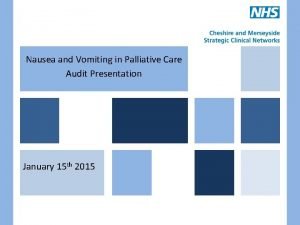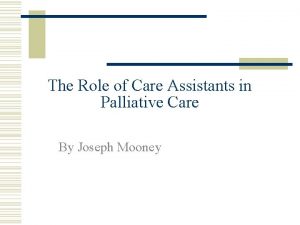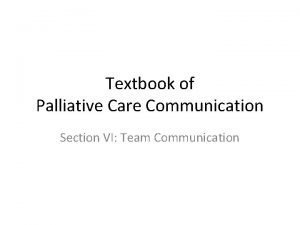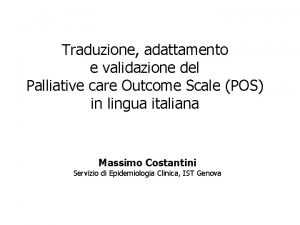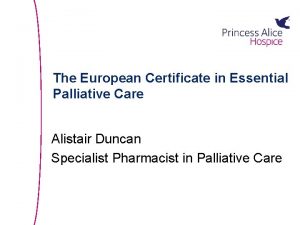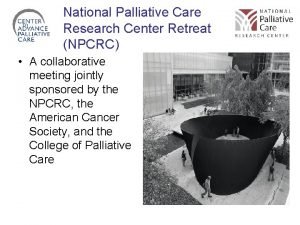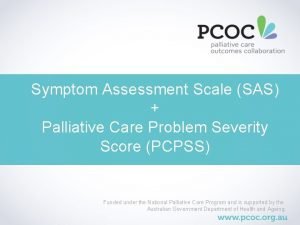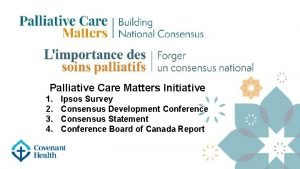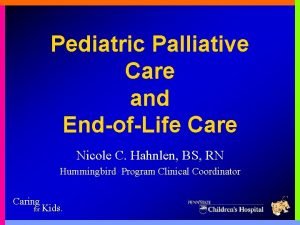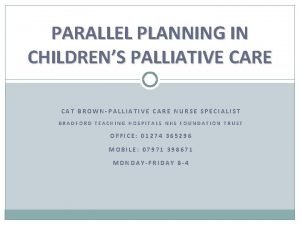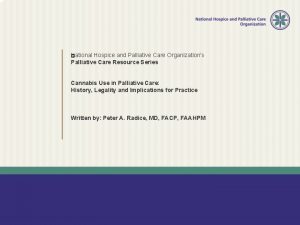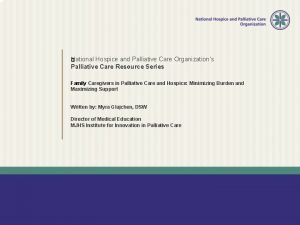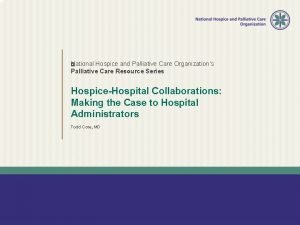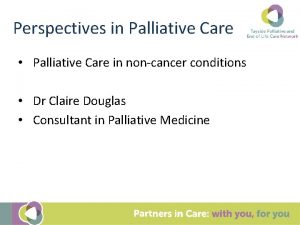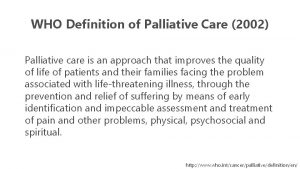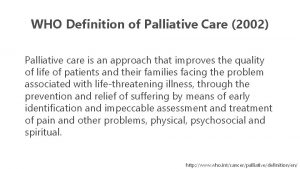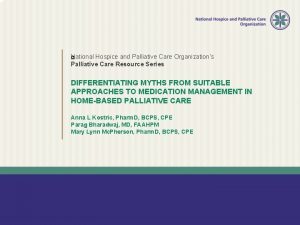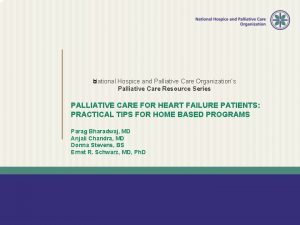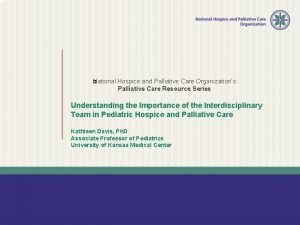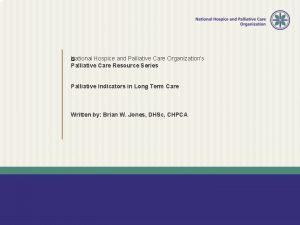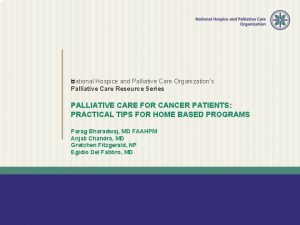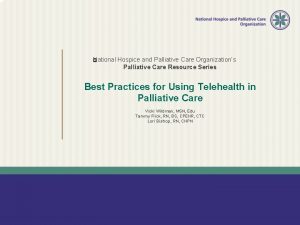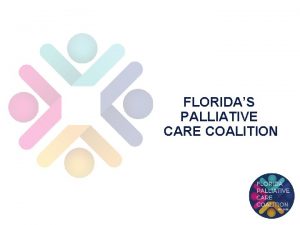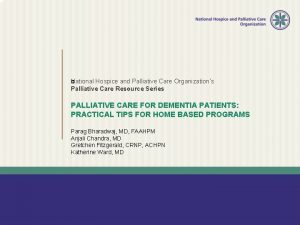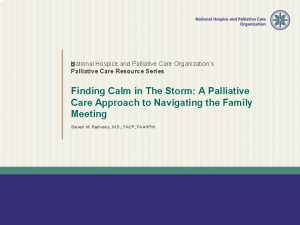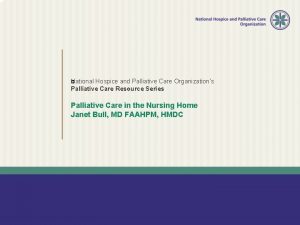What is palliative care Palliative care is the
























- Slides: 24


What is palliative care ? Palliative care is the care of patients with active, progressive, far -advanced disease and a short life expectancy, for whom the focus of care is the relief and prevention of suffering and the quality of life. International Association for Hospice and Palliative Care

What is palliative care ? Palliative care is an approach that improves the quality of life of patients and their families facing the problems associated with life-threatening illness, through the prevention and relief of suffering by means of early identification and impeccable assessment and treatment of pain and other problems, physical, psychosocial and spiritual. WHO, 2002

Palliative care n n n Provides relief from pain and other distressing symptoms Affirms life and regards dying as a normal process Intends neither to hasten nor postpone death Integrates the psychological and spiritual aspects of care Offers a support system to help patients live as actively as possible until death WHO, 2002

Palliative care n n Offers a support system to help the family cope during the patient’s illness and in their own bereavement Uses a team approach to address the needs of patients and their families, including bereavement counseling, if indicated Will enhance the quality of life, and may also positively influence the course of the illness Is applicable early in the course of illness, in conjunction with otherapies that are intended to prolong life, such as chemotherapy or radiation therapy, and includes those investigations needed to better understand manage distressing clinical complications. WHO, 2002

Palliative care: types of cases n Traditionally, patients with n n advanced cancer end stage organ failures like intractable heart failure, renal failure, liver failure, respiratory failure and late stage neurodegenerative diseases like motor neuron disease, Parkinson’s disase, dementia. More recently, included patients who is n dying from acute illnesses and no longer responding to active treatment e. g. in ICU.

Continuum of care


End-of-life care

What is wrong with end-of life care ? Opinions of bereaved family members n n 9% of decedents received CPR, 11% ventilator support, and 24% intensive care during their last month of life A discussion of treatment decision could not be recalled in 23% of cases More care to relieve pain or other symptoms was indicated in 18% of deaths Family members’ recommendations to improve end of life care emphasized better communication (44%), greater access to physicians’ time (17%), and better pain management (10%) Hanson LC, et al. J Am Geriatr Soc 1997 ; 45 : 1339 -44

Family perspectives on end-of-life care n n Over three quarters (78%) believed that there was not enough contact with the patients' physicians half reported insufficient information in regard to what to expect from the dying process Over half of the respondents believed that there was not enough emotional support for patients One fifth believed that pain or shortness of breath was inadequately treated Teno JM, Clarridge BR, Casey V, et al. JAMA. 2004; 291: 88 -93

Quality end-of-life care: Patient’s perspectives Qualitative study using in-depth, open-ended, face-to-face interviews 126 participants (dialysis, HIV, NH residents) 5 domains of quality end-of-life care: n Receiving adequate pain and symptom management n Avoiding inappropriate prolongation of dying n Achieving a sense of control n Relieving burden n Strengthening relationships with loved ones Singer PA, Martin DK, Kelner M. JAMA 1999 ; 281 : 163 -8

In search of a good death: Observations of patients, families, and providers Qualitative study using focus group and in-depth interviews 12 focus groups, 6 -8 participants each 6 major components of good death: n Pain and symptom management n Clear decision making n Preparation for death n Completion n Contributing to others n Affirmation of the whole person Steinhauser KE, et al. Ann Intern Med 2000 ; 132 : 825 -32

Good death • Free from avoidable distress and suffering for patients, families, caregivers • In general, according with patients’ and families’ wishes • Reasonable consistent with clinical, culture, and ethical standards Institute of Medicine 1997

Principles of good death • To know when death is coming, and to understand what can be expected • To be able to retain control of what happens • To be afforded dignity and privacy • To have control over pain relief and other symptom control • To have choice and control over where death occurs • To have access to information and expertise of whatever kind is necessary Smith R. Br Med J 2000; 320: 129 -30

Principles of good death (cont. ) • To have access to any spiritual or emotional support required • To have access to hospice care in any location • To have control over who is present and who shares the end • To be able to issue advance directives which ensure wishes are respected • To have time to say goodbye, and control over other aspects of timing • To be able to leave when it is time to go, and not to have life prolonged pointlessly Smith R. Br Med J 2000; 320: 129 -30








Take home message The message of palliative care is that whatever the disease, however advanced it is, whatever treatment have already been given, there is always something which can be done to improve the quality of the life remaining to the patient.
 Palliative care vs hospice care
Palliative care vs hospice care Anergia definition
Anergia definition Franciscan palliative care
Franciscan palliative care Calvary palliative care
Calvary palliative care Rug-adl score
Rug-adl score Ondansetron palliative care
Ondansetron palliative care Palliative care assistant
Palliative care assistant Goc palliative care
Goc palliative care Goscote palliative care centre
Goscote palliative care centre Textbook of palliative care communication
Textbook of palliative care communication Validazione pos
Validazione pos Anorexia palliative care
Anorexia palliative care Hospice satisfaction survey
Hospice satisfaction survey Just in case bag palliative care
Just in case bag palliative care European certificate in palliative care
European certificate in palliative care Npcrc
Npcrc Palliative care at home barry
Palliative care at home barry Oacc palliative care
Oacc palliative care Symptom assessment scale palliative care
Symptom assessment scale palliative care Palliative care matters
Palliative care matters Principles of palliative care
Principles of palliative care European delirium association
European delirium association Parallel planning palliative care
Parallel planning palliative care Bluegrass care navigators hazard ky
Bluegrass care navigators hazard ky Esas-r
Esas-r





